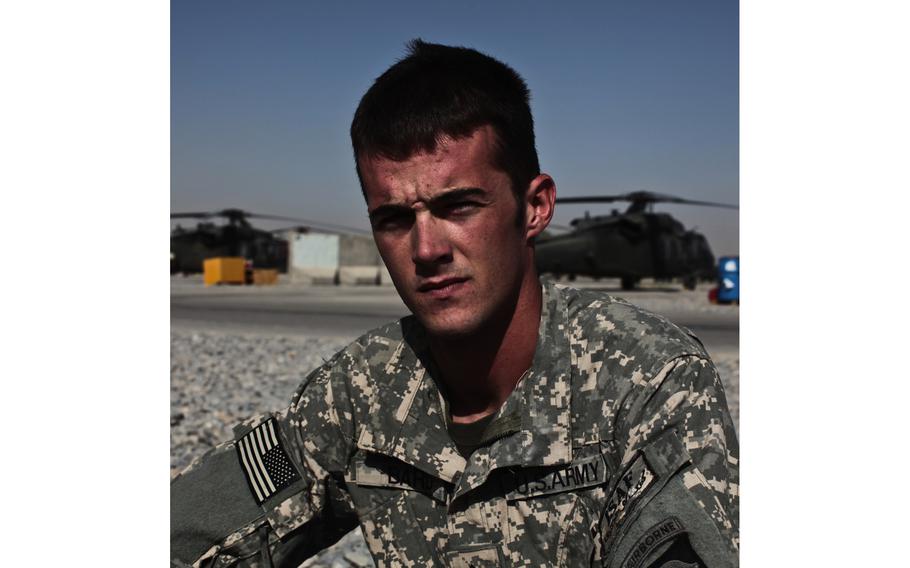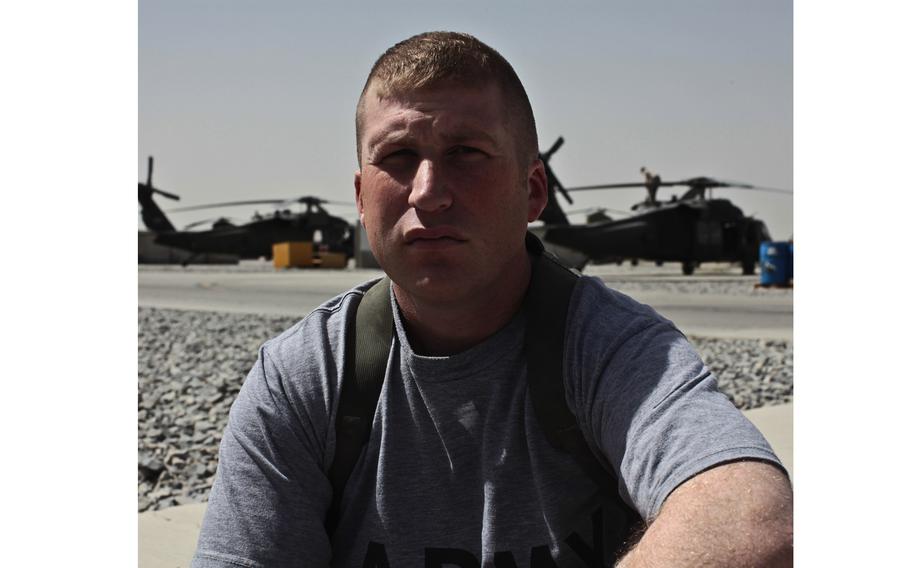
Cpl. Samuel Bard, 23, of Paducah, Ky., served as crew chief for a UH-60 Black Hawk helicopter ambulance crew that saved the lives of two severely wounded soldiers during a firefight July 4 near Combat Outpost Terranova in the Arghandab Valley, northwest of Kandahar, Afghanistan. Sept. 21, 2010. (Drew Brown/Stars and Stripes)
The Fourth of July had been an easy day for flight medic Staff Sgt. Bradley Robbins and crew chief Cpl. Samuel Bard. The pair had not flown a single mission. At 4:40 p.m., their helicopter ambulance crew got the call: Three critically injured men were pinned down in a firefight near Combat Outpost Terra Nova.
Robbins and Bard knew they were going in hot. The troops on the ground had reported their position as only 400 yards from the outpost, but the Taliban fire was so intense, they could not move.
Robbins, 34, of Clarksville, Tenn., was on his fourth tour, his second as a flight medic. Bard, 23, of Paducah, Ky., was brand new to the war.

Staff Sgt. Bradley Robbins, 34, of Clarksville, Tenn., served as a flight medic with a helicopter ambulance crew that saved the lives of two wounded soldiers during firefight on July 4th near Combat Outpost Terranova, in the Arghandab Valley, northwest of Kandahar, Afghanistan. Sept. 20, 2010. (Drew Brown/Stars and Stripes)
Both would experience the kind of combat they hope to never see again.
The ground soldiers waved the Black Hawk off from its first attempt to land. They were taking too much fire. But after 15 minutes, the most critical of the patients had worsened.
“We could go in and get them,” Bard said, “or we could sit and let them die. ... It was one of those moments when you think, ‘This is going to be the stupidest thing I ever do in my life, or I’m going to benefit from it.’”
They came down fast and hard in a muddy field just large enough for the helicopter to land. Robbins was thrown against the pilot's seat, and Bard remembered mud flying up into the swirling rotor blades. A soldier near an apple orchard waved them forward. As they started from the aircraft, all they could hear was gunfire.
"It was just a tremendous amount of fire," Robbins recalled. "I was told later that they were taking fire from three sides."
Bard went down in a ditch, then took cover next to a wall. Over his left shoulder, he saw two Taliban fighters 50 yards away, shooting at the Black Hawk as it sat in the field, rotors turning.
Bard's mother, a police officer, had taught him to shoot at an early age. He drew his 9mm pistol without thinking and shot the two fighters dead.
"When I saw those guys moving towards the aircraft, I wasn't having it," he said. "It was like an out-of-body experience."
The next thing he knew he was flat on his back in the mud, his ears ringing. A Taliban mortar round had exploded within 10 yards of him. Robbins recalled watching Bard fly up into the air when the round exploded, "just like in the movies."
Somehow, he had not been hit.
Robbins started to move toward the apple orchard where most of the soldiers were pinned down, including the wounded. As he got up, he saw a trip wire on the ground.
"The IED that got the guys was on the left," he said. "An unexploded one was on the right. Bard had gone right over it."
Robbins stepped over the wire and stayed low, moving into another ditch, where he was up to his neck in water. A Taliban fighter appeared 40 to 50 yards in front of him to the left.
"I engaged and emptied my magazine and didn't see the enemy combatant move anymore," he said.
Robbins reached the wounded and was soon joined by Bard. One soldier was dead. Another had been shot in the leg, but could still walk. Bard sent him back to the aircraft, while he stayed to pull security on Robbins, who was working on the third casualty.
The soldier had been hit in the face by shrapnel, and was breathing by means of a tracheotomy, but his breathing was erratic and labored. Robbins got him onto a litter, and with other soldiers helping, they started to move out. Heavy machine gun fire erupted again.
Robbins recalled having a "surreal moment" when he looked around the orchard and briefly imagined couples sitting together under the trees.
"Wow. This is Afghanistan," he remembered thinking.
"Then I heard a couple of really loud booms, and the tree in front of me was just gone," he said.
The Taliban were firing what he believed to be a Soviet-made 12.7mm "Dshka" heavy machine gun; essentially the equivalent of the .50 cal mounted on MRAPs and Humvees.
As the ground element returned fire, Robbins and Bard dashed across the field, carrying the patient on the stretcher. Overhead, Apache gunships and Kiowa helicopters did numerous runs, firing at Taliban positions.
Despite the heavy fire, Robbins and Bard reached the aircraft unscathed. The soldier with the leg wound lay aboard, "screaming bloody murder," Bard recalled.
He estimated that they had been on the ground maybe five minutes.
"It was so surreal," he said. "Five minutes felt like forever," he said.
They took off and headed at top speed for the hospital at Kandahar. Once the patients were in the back of an ambulance, the significance of what they had just been through hit him, Bard said.
"I put my legs on the ground, and my legs got weak," he said. "I had to get back on the aircraft and sit down. I just started crying, and I'm not ashamed to admit it."
Robbins, too, was spent.
"I was just shaking," he said. "I had to sit down on the ground."
The two were recommended for decorations for bravery.
The soldiers of Task Force Shadow received a letter about a month ago from the soldier who had been hit in the face. He had survived.
"Basically, it was a thank-you letter to everyone who had helped him that day," said Robbins. "It's pretty gratifying to get something like that."
Read more here.